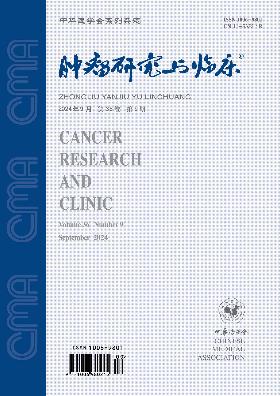中国单中心肺腺癌患者基因突变特征及与欧美肺腺癌人群的比较
Q4 Medicine
引用次数: 0
摘要
目的探讨肺腺癌基因突变的特点及意义,为靶向治疗肺腺癌提供依据。方法对104例肺腺癌患者进行高通量测序,检测56个癌相关基因的突变情况。所有患者均于2017年5月至2018年8月在昆山市第一人民医院确诊。分析了肺腺癌的突变特征,并与欧美肺腺癌人群进行了比较。分析突变特征与临床特征的相关性,筛选靶向用药的突变位点。结果104例肺腺癌患者中,84例共检出34个突变基因,占84/104的81%。高频率突变包括表皮生长因子受体(EGFR)(49%, 51/104)、TP53(21%, 22/104)、KRAS(13%, 14/104)和BRAF(6%, 6/104)。其中76%(142/187)为非同义错义突变,13%(24/187)为小片段缺失,6%(12/187)为拷贝数变异,3%(5/187)为小片段插入,2%(4/187)为无义位点突变。在104例肺腺癌患者中,68例(65%)患者检测到13个基因的34个靶向药物相关突变,19例(18%)患者检测到≥2个靶向药物相关突变。EGFR突变在女性患者中比在男性患者中更常见[62% (34/55)vs。35% (17/49), χ2= 7.629, P= 0.006],男性患者KRAS突变发生率高于女性患者[22%(11/49)比5% (3/55),χ2= 6.424, P= 0.011]。中国单中心(昆山第一人民医院)与欧美腺癌人群EGFR、TP53、KRAS、CDKN2A基因突变频率差异有统计学意义(均P < 0.05)。结论肺腺癌分子突变特征复杂,不同人群间差异较大。基于高通量测序的多基因检测能全面揭示其突变特征,在个人靶向用药指导、耐药监测和预后评估等方面具有重要作用。关键词:肺肿瘤;腺癌;高通量核苷酸测序;突变;分子靶向治疗本文章由计算机程序翻译,如有差异,请以英文原文为准。
Characteristics of gene mutations in Chinese single-center pulmonary adenocarcinoma patients and comparison with European and American pulmonary adenocarcinoma populations
Objective
To explore the characteristics and significances of gene mutations in pulmonary adenocarcinoma, and to provide evidence for targeted medication.
Methods
High throughput sequencing based target-capture sequencing was performed in 104 patients with pulmonary adenocarcinoma to detect the mutational status of 56 cancer-related genes. All patients were diagnosed in the First People's Hospital of Kunshan from May 2017 to August 2018. The mutational characteristics of pulmonary adenocarcinoma was analyzed and compared with European and American pulmonary adenocarcinoma populations. The correlations between mutational characteristics and clinical features were analyzed, and the mutation sites for targeted medication were screened.
Results
Among 104 patients with pulmonary adenocarcinoma, totally 34 mutational genes were detected in 84 patients (81%, 84/104). Highly frequent mutations included epidermal growth factor receptor (EGFR) (49%, 51/104), TP53 (21%, 22/104), KRAS (13%, 14/104), and BRAF (6%, 6/104). Among all the 187 variants, 76% (142/187) were non-synonymous missense mutations, 13% (24/187) were small fragment deletions, 6% (12/187) were copy number variants, 3% (5/187) were small fragment insertions, and 2% (4/187) were nonsense site mutations. Among 104 patients with pulmonary adenocarcinoma, 34 targeted drug-associated mutations of 13 genes were detected in 68 patients (65%), and 19 (18%) patients harbored ≥ 2 targeted drug-associated mutations. EGFR mutations were more common in female patients than in male patients [62% (34/55)vs. 35% (17/49), χ2= 7.629, P= 0.006], while KRAS mutations were more frequent in male patients than in female patients [22% (11/49) vs. 5% (3/55), χ2= 6.424, P= 0.011]. The mutation frequencies of gene EGFR, TP53, KRAS, and CDKN2A in Chinese single-center (the First People's Hospital of Kunshan) and European and American adenocarcinoma populations were significantly different (all P < 0.05).
Conclusions
The molecular mutational characteristics of pulmonary adenocarcinoma are complex, and vary greatly among different populations. High throughput sequencing-based multiple-gene detection can reveal its mutational features comprehensively, and that has important roles in personal targeted medication guidance, drug-resistance monitoring and prognosis evaluation.
Key words:
Lung neoplasms; Adenocarcinoma; High-throughput nucleotide sequencing; Mutation; Molecular targeted therapy
求助全文
通过发布文献求助,成功后即可免费获取论文全文。
去求助
来源期刊

肿瘤研究与临床
Medicine-Oncology
CiteScore
0.10
自引率
0.00%
发文量
7737
期刊介绍:
"Cancer Research and Clinic" is a series of magazines of the Chinese Medical Association under the supervision of the National Health Commission and sponsored by the Chinese Medical Association.
It mainly reflects scientific research results and academic trends in the field of malignant tumors. The main columns include monographs, guidelines and consensus, standards and norms, treatises, short treatises, survey reports, reviews, clinical pathology (case) discussions, case reports, etc. The readers are middle- and senior-level medical staff engaged in basic research and clinical work on malignant tumors.
 求助内容:
求助内容: 应助结果提醒方式:
应助结果提醒方式:


